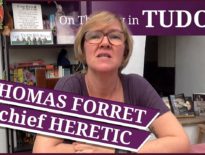On this day in Tudor history, 29th February 1604, John Whitgift, Archbishop of Canterbury, died at at Lambeth Palace, the archbishop’s palace in London. He was the last Archbishop of Canterbury in Queen Elizabeth I's reign, and the queen called him her "white gift" and her "little black husband".
He is known for his religious disagreement, but also had a real heart for the poor. Find out more about Archbishop John Whitgift in today's talk.
Also on this day in Tudor history, 29th February 1528, Scotland’s first Protestant martyr was burned to death – theologian Patrick Hamilton. See last year’s video for 28th and 29th February:
Also on this day in history:
- 1468 – Birth of Alessandro Farnese at Canino, Latium, which was in the Papal States. Farnese was elected as pope in 1534, becoming Pope Paul III, and was pope until his death in 1549.
Transcript:
On this day in Tudor history, 29th February 1604, John Whitgift, Archbishop of Canterbury, died at at Lambeth Palace, the archbishop’s palace in London. He was the last Archbishop of Canterbury in Queen Elizabeth I's reign, and had been in office since 1583.
Here are some facts about this Archbishop of Canterbury…
• John Whitgift was born in around 1530/1531 and was the eldest son of Henry Whitgift of Great Grimsby, Lincolnshire, and his wife, Anne Dynewell.
• Whitgift’s uncle, Robert, provided for the boy’s education, first at the Augustinian house where he was abbot in Wellow, and then at St Anthony’s School in London, Queen’s College, Cambridge, and Pembroke College. He graduated BA in 1554.
• In 1555, he became a fellow at Peterhouse College, where he obtained his MA in 1557, rather than fleeing into exile as other Protestants did in Mary I’s reign. He appears to have been protected by the Vice Chancellor Andrew Perne, his good friend.
• In 1560, following the accession of Queen Elizabeth I, he was ordained deacon at Ely and then a priest, and he also acted as the Bishop of Ely’s chaplain. He regularly denounced the pope as the Anti-Christ in his sermons.
• He obtained his Bachelor of Theology from Peterhouse in 1563 and was appointed Lady Margaret Professor of Divinity, becoming known for his anti-papal stance.
• Although he was against the wearing of the surplice originally, he eventually sided with government policy and preached in its defence. His support of the government brought him favour from William Cecil and helped his career enormously. He obtained his doctorate in theology in 1567 and was made regius professor of divinity. He was also master of Pembroke College temporarily, before becoming master of Trinity College.
• Queen Elizabeth I called him her “White gift” because of his talent for preaching. She also called him “her little black husband”.
• In 1571, he was elected dean of Lincoln and became Vice Chancellor at Cambridge in 1573. He became Bishop of Worcester in 1577.
• He is known for his religious disagreements, in the pulpit and in pamphlets, with Puritan Thomas Cartwright, who was forced into exile.
• As far as Whitgift’s personal faith is concerned, his biographer William Joseph Sheils, writes of his Calvinist theology and how he believed that scripture was central to defining the nature of the Church.
• During his time as Bishop of Worcester, he was very concerned with recusancy and acted against Catholics in his diocese.
• On 14 August 1583, following the death of Edmund Grindal, Whitgift was nominated as Archbishop of Canterbury. He was eager to reform the church and to take action against Catholics and those who did not attend church. He upset Puritans in the church with his endorsement of the Book of Common Prayer as the only prayer book that should be used in public worship. Further anti-Puritan measures followed.
• In 1588, Whitgift was one of those targeted in the Marprelate Controversy, with the tracts attacking the established church referring to him as “that miserable, and desperate caytiffe wicked John Whitgift, the Pope of Lambehith”.
• He cared for the poor. One Christmas, he and his household sat down to eat with the poor, he would top up the poorer livings in his diocese, and he founded an almshouse in 1595 and a then a school. He also encouraged bishops to to remind their clergy and the wealthy in their areas of their duty to the poor.
• Whitgift was at Queen Elizabeth’s bedside when she died on 24th April 1603 and acted as chief mourner at her funeral. He was also at the council that proclaimed King James VI of Scotland as king of England and provided the new king with a report on the church in England.
• In February 1604, he caught a cold and then suffered a stroke while dining at Whitehall. He died on this day in history, 29th February 1604. He was buried on 27th March 1604 in the Chapel of St Nicholas at Croydon Minster. He made significant bequests to the poor in his will, and also left provisions for his school and hospital.



Leave a Reply